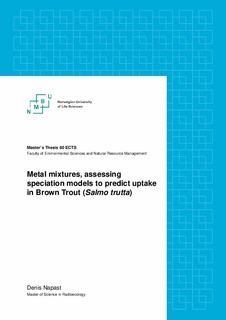| dc.description.abstract | Alum shale is an organic-rich rock which contains high concentrations of U, Ni, V, Mo, Co, Cu, Zn, As and other metals. These metals are released into the environment by human actives and rock weathering. Many different metals can be found in water as a mixture that can be taken up by aquatic organisms and cause adverse effects and harm.
Uptake of metal mixtures by fish is a complex process that depends on several factors such as pH, temperature, water hardness, element species, the presence of dissolved organic carbon and others. To predict the uptake of metals by fish, computer models like WHAM 7 and Visual Minteq 3.1 are used. These computer models attempt to describe the complex behavior of metals in water, while considering their chemical speciation, charge, amount and complexation with organic matter. The simulated amount of bounded metals to the fish gill was compared to other prediction methods such as free-ion concentration and total metal concentration.
In this project WHAM 7 and Visual Minteq 3.1, developed to predict metal binding to fulvic acid and humic acid, were used to predict metal binding to a fish gill from the assumption that a gill has similar metal binding properties as humic acid. The input data used in both models was obtained from leeched alum shale samples taken from a tunnel and road construction site in Norway as part of the NORWAT research.
This master thesis has focused on U, Sr, Cd, Ni and V. From the results we see that the metal mixture approach from these models adjusts better to reality than the freeion concentration or the total metal concentration approaches. WHAM predicted better for Cd, Ni and V, meanwhile Minteq gave better results for U and Sr. Both WHAM and Minteq predicted more than 50% lower ratios, compared to the free-ion concentration and the total metal concentration. Further model development and model adjustments are needed to improve the predicted metal uptake by fish. Both models performed good, considering that they were not designed as an estimation tool for metal uptake to aquatic organisms. | nb_NO |

